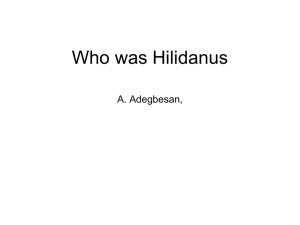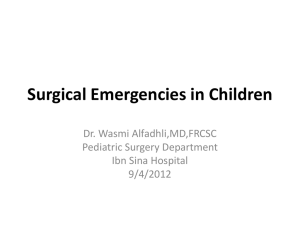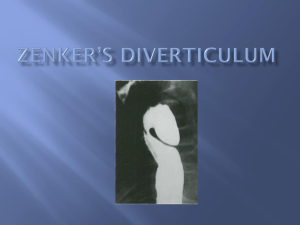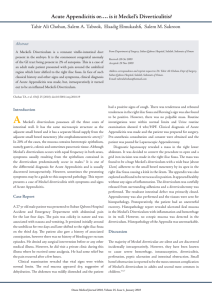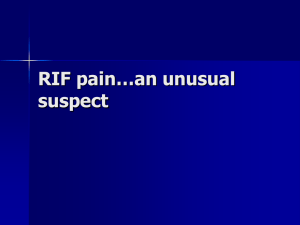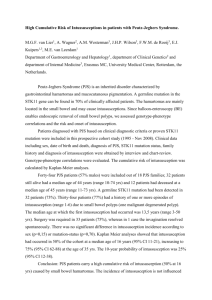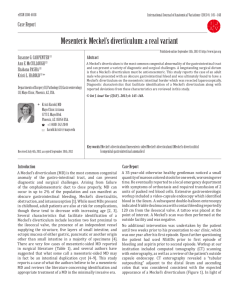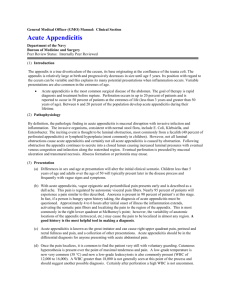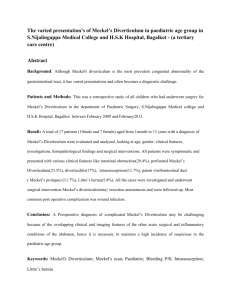I 1 Randomised double blinded placebo controlled study to evaluate
advertisement
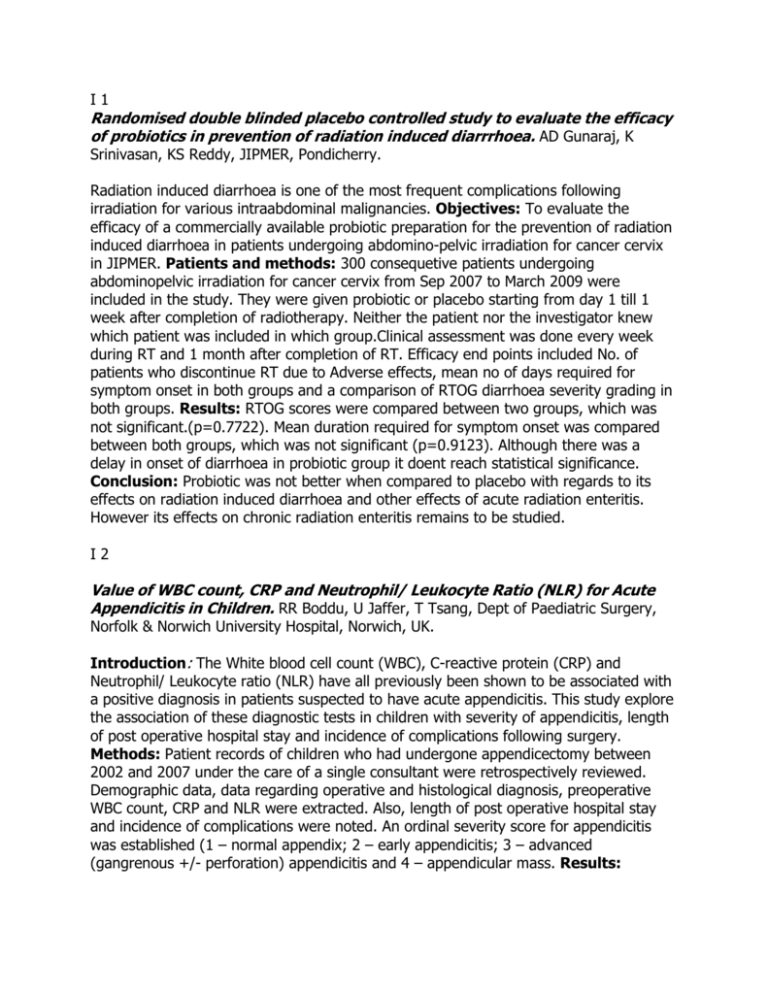
I1 Randomised double blinded placebo controlled study to evaluate the efficacy of probiotics in prevention of radiation induced diarrrhoea. AD Gunaraj, K Srinivasan, KS Reddy, JIPMER, Pondicherry. Radiation induced diarrhoea is one of the most frequent complications following irradiation for various intraabdominal malignancies. Objectives: To evaluate the efficacy of a commercially available probiotic preparation for the prevention of radiation induced diarrhoea in patients undergoing abdomino-pelvic irradiation for cancer cervix in JIPMER. Patients and methods: 300 consequetive patients undergoing abdominopelvic irradiation for cancer cervix from Sep 2007 to March 2009 were included in the study. They were given probiotic or placebo starting from day 1 till 1 week after completion of radiotherapy. Neither the patient nor the investigator knew which patient was included in which group.Clinical assessment was done every week during RT and 1 month after completion of RT. Efficacy end points included No. of patients who discontinue RT due to Adverse effects, mean no of days required for symptom onset in both groups and a comparison of RTOG diarrhoea severity grading in both groups. Results: RTOG scores were compared between two groups, which was not significant.(p=0.7722). Mean duration required for symptom onset was compared between both groups, which was not significant (p=0.9123). Although there was a delay in onset of diarrhoea in probiotic group it doent reach statistical significance. Conclusion: Probiotic was not better when compared to placebo with regards to its effects on radiation induced diarrhoea and other effects of acute radiation enteritis. However its effects on chronic radiation enteritis remains to be studied. I2 Value of WBC count, CRP and Neutrophil/ Leukocyte Ratio (NLR) for Acute Appendicitis in Children. RR Boddu, U Jaffer, T Tsang, Dept of Paediatric Surgery, Norfolk & Norwich University Hospital, Norwich, UK. Introduction: The White blood cell count (WBC), C-reactive protein (CRP) and Neutrophil/ Leukocyte ratio (NLR) have all previously been shown to be associated with a positive diagnosis in patients suspected to have acute appendicitis. This study explore the association of these diagnostic tests in children with severity of appendicitis, length of post operative hospital stay and incidence of complications following surgery. Methods: Patient records of children who had undergone appendicectomy between 2002 and 2007 under the care of a single consultant were retrospectively reviewed. Demographic data, data regarding operative and histological diagnosis, preoperative WBC count, CRP and NLR were extracted. Also, length of post operative hospital stay and incidence of complications were noted. An ordinal severity score for appendicitis was established (1 – normal appendix; 2 – early appendicitis; 3 – advanced (gangrenous +/- perforation) appendicitis and 4 – appendicular mass. Results: 121 patients (71 male, 50 female) were included in the study. Mean age was 11.03 years (range: 2.37 to 16.3 years). Mean operation time was 74 mins (range 21 to 140 mins). Mean length of stay was 3 days (range: 1 to 24). 19 patients had post operative complications and 5 records were incomplete. Complications include surgical site infections (wound and intra-abdominal) and post operative ileus. 15 had a normal appendix, 41 had early appendicitis, 48 had advanced (gangrenous +/- perforation) appendicitis,14 had an appendicular mass and 3 records were incomplete. Using Censlope (Newson) and Somers D statistic, we found, a one unit increase in WBC count, NLR and CRP predicted 8% (7% to24% , p=0.279); 18% (5% to 31%, p=0.001); and 28% (11% to 46%, p=0.001) increase in length of hospital stay respectively. Using logistic regression, CRP but not WBC or NLR was associated with the incidence of a post operative complications (p = 0.006). Using ordinal logistic regression, a one unit increase in WBC count, NLR and CRP predicted negative odds ratio of 0.83 (0.77 to 0.9; p < 0.0001); 0.93 (0.88 to 0.97; p = 0.003); and 0.98 (0.98 to 0.99; p < 0.0001) respectively of having normal appendix. Conclusions: Increased WBC count, NLR and CRP were found to be associated with a decreased likelihood of a normal appendix. Increased NLR and CRP were associated with increased length of hospital stay. Increased CRP alone was associated with incidence of post-operative complications. I3 Laparoscopic appendicectomy for complicated appendicitis: Is it safe and justified? P Kumar, N Mohan, R Ardhanari, Meenakshi Mission Hospital & Research Center, Madurai. Background: Although laparoscopic appendectomy has some advantages over open appendectomy but the literature suggest conflicting results regarding postoperative complications for complicated appendicitis. Methods: A retrospective review of complicated appendicitis managed surgically at MMHRC, Madurai, Tamilnadu, India was undertaken. Among 525 patients with appendicitis, 189 (36%) had complicated appendicitis, which included gangrenous, perforated appendicitis, mass, or abscess with or without localized or disseminated peritonitis. The age group varied from 682years.There were preoperative abscesses in about 25% and 9% had peritonitis at presentation. Results: No mortality. There were 2.5% who developed postoperative intraabdominal abscesses and 4% developed complications. Conversion to laparotomy was necessary for 14 patients. The surgical time ranged from 25 to 160 min (mean, 80 min), and the hospital stay ranged from 1 to 18 days (mean, 3.5 days). Conclusions: The morbidity rates, particularly for intraabdominal abscesses and wound infection, were low for laparoscopic appendectomy in complicated appendicitis than those reported in the literature for open appendectomy, whereas operating times and hospital stays were similar. I4 A Study of Early Proximal Ostomies in cases of Complicated Enterocutaneous Fistulas. S Kapoor,NR Singh, J Singh, A Singh, Government Medical College, Amritsar. Introduction: Postoperative enterocutaneous fistulas present difficulties in management, with the principal causes of mortality being sepsis and malnutrition.Aims and Objectives: Prospective study of the role of early proximal loop ileostomies in cases of complicated entero-cutaneous fistulas. Materials and Methods:This study was conducted on 40 cases of complicated enterocutaneous fistulas admitted in surgical ward of Govt. Medical College, Amritsar.All cases were of post-operative enterocutaneous fistulas. Majority of cases were of high output type showing the features of intra-abdominal collections and sepsis. Procedures included drainage of collections, lysis of adhesions, resection of bowel or fistulous segments with anastomosis and proximal loop ileostomy in a healthy part of the gut. Results: In 30 out of 40 cases, exploration with drainage of intra-peritoneal collections, resection/repair of the devitalised part and repair of the gut was done and proximal loop ostomies (ileostomies) were created. These patients did well post operatively without any major post-operative complications in most of the cases. Those 6 cases in which primary repair was done, had to be re-explored and treated on the same line of proximal loop ileostomy. They also responded well post-operatively except 4 cases that died during the course of treatment. Conclusion: Early proximal loop ileostomy may help healing in complex enterocutaneous fistulas. I5 Is duodenojejunostomy an adequate procedure for SMA syndrome? HV Shivaram, N Satish, NK Jairam, Columbia Asia Referral Hospital, Bangalore. SMA syndrome is an uncommon disease causing severe distress to the patient. When surgery is needed the standard procedure is side to side duodenojejunostomy (DJ) either open or laparoscopic. This procedure is supposed to give good results in 90% of cases. Our experience with 5 patients showed that due to mega duodenum the DJ takes long time to function (sometimes many months) and the patient continues to vomit post-operatively. Managing the vomiting and maintaining adequate nutrition becomes difficult. Also the patient feels surgery has not benefitted him/her. Hence we added routinely the feeding jejunostomy (FJ) and tube gastrostomy (TG) in these cases. These two procedures when added to DJ helped in preventing the post-operative vomiting and maintaining the nutrition till the DJ started to function. It may be appropriate to add FJ and TG while performing DJ for SMA syndrome. I6 Obstructed Meckels diverticulum due to inspissated faecal matter: a rare case. AP Rozario, HB Suresh, R Philip, St John’s Medical College, Bangalore. Case Report: A 32-year old female had presented to the emergency room complaining of mild abdominal distention, diffuse abdominal pain, vomiting and obstipation. There was no history of fever. Her white blood cell count was 12,700 with left shift. She was tubectomised 8 yrs back. Abdominal x rays revealed air fluid levels within mildly dilated loops of small bowel,consistent with early intestinal obstruction. An ultrasound scan of the abdomen showed dilated (3.3cm) thickened,hypoperistaltic bowel loops with minimal free fluid in the abdomen.The patient underwent laparotomy after twenty-four hours of observation. During exploratory laparotomy, around 500 ml of non foulsmelling serous fluid was found in the peritoneal cavity. Dilated small bowel loops were encountered and an outpouching of small bowel was found on the antimesenteric border,representing a Meckel’s diverticulum. It was 3 cm in diameter,wide mouthed,located approximately 50 cm proximal to the ileocaecal valve and inspissated with hard faecal matter.Bowel distal to it was collapsed. The diverticulum containing the hard faecal matter were resected and end to end hand sewn two layered anastomosis performed. Pathologic examination of the surgical specimen showed presence of diverticulum lined by small intestinal mucosa with presence of submucosa and muscularis propria without any ectopic tissue (colonic/gastric/pancreatic). Features were consistent with Meckels diverticulum (true diverticulum) without any signs of inflammation. Upon follow up a week after discharge the patient was asymptomatic. Conclusion: Inspissated fecal matter within a Meckel’s diverticulum leading to intestinal obstruction is rare with less than 10 cases reported in literature. I7 An unusual cause of pyrexia of unknown origin(PUO). Shabeerali, R Rajan, K Balachandran, Medical College, Thiruvananthapuram. Case report:A twenty nine year old male presented to the Department of Internal Medicine with fever of one month duration. Clinical examination was unremarkable.Routine laboratory and biochamical tests showed leucocytosis and markedly elevated erythrocyte sedimentation rate.Ultrasonography(USG) of the abdomen was performed which revealed a hypoechoic mass lesion of size 5cm in the left paraaortic region. Contrast enhanced computerized tomogram (CECT) of abdomen showed a homogenously enhancing hypodense mass lesion in relation to the mesentery of proximal small bowel with few enlarged mesenteric lymphnodes. At laparotomy there was a firm smooth surfaced mass of size 6X5cm in the mesentery of mid jejunum with a separate 1x1cm nodule in the nearby mesentery. The tumour was excised with adequate margins along with corresponding jejunal segment and end to end anastomosis done.Histopathology was suggestive of inflammatory myofibroblastic tumor.On immunohistochemistry, more than 50% of cells where positive for p53. The patient had an uneventful recovery. His fever subsided and the ESR came back to normal in two weeks time. Discussion: Inflammatory myofibroblastictumor is a rare neoplasm. Lung is the most common site of this tumor. PUO, constitutional symptoms or a palpable mass are the the common presentations.These tumors usually have benign course but with apotential for aggressive behavior like local recurrence and metastasis.The predictors for aggressive behavior include the presence of ganglion like cells ,cellular atypia,DNA aneuploidy and p53 expression. Conclusion: IMT is a rare tumor with varying presentations and unpredictable behavior.This tumor should be considered as a differential diagnosis when a solid tumor is presenting with fever and constitutional symptoms. USG of the abdomen should be considered in the early stages of the algorithm of PUO before going in to expensive and invasive inestigations. I8 A rare case of intestinal lipomatosis leading to jejuno-jejunal intussusceptions. S Ghosh, BH Anand Rao, P Shetty, Kasturba Medical College, Manipal. Dr. Shirsak Ghosh **, Dr. B. H. Anand Rao *, Dr. Prashanth Shetty, Dr. Rashid Ahmad Khan Kasturba Medical College and Hospital, Manipal, Karnataka. Lipomatosis of the small bowel was first described by Hellstrom in 1906. Lipomatosis involving the gastrointestinal tract is a rare disorder, for which few cases have been reported in medical literature. Benign tumors of the small bowel are relatively rare; lipomas are among the most common ones, second being leiomyoma, with an incidence in autopsy ranging from 0.04% to 4.5%. The term lipomatosis has been used to describe the presence of numerous circumscribed lipomas in the intestine. Case reports of lipomas in isolated or scattered segments are most frequently encountered in the literature. Lipomas are the most common benign tumors of the intestines. Symptoms occur in less than one-third of affected patients, especially when the lipomas are more than 2 cm in size. Most intestinal lipomas are solitary and submucosal in location. The ileum is the most commonly affected site. There is no satisfactory explanation for the etiology of gastrointestinal lipomatosis. No gender predilection is observed. The most frequent presenting symptom is abdominal pain. Some patients with lipomatosis have a familial history, suggesting an autosomal dominant inheritance. Hypercholesterolemia has also been reported often, but this was not found in our patient. Lipomatosis usually occurs after the fourth decade of life. Intestinal lipomatosis is a very rare condition. Intussusception is one of the causes of intestinal obstruction and often seen in children younger than 2 years old. Adult cases are seldom encountered, and they often have underlying intestinal tumor as the leading point of intussusception. Lipomatosis of the intestine causing intussusception and intestinal obstruction is an even rarer condition. Here I present a 45-year-old lady with lipomatosis involving small bowel leading to jejuno-jejunal intussusception. I9 Inverted meckel’s diverticulum with nonobstructive ileo- ileal intussusception presenting with melena T Shaikh, P Tunganwar, M Suryawanshi, D Rajpal, MJ Algotar, Grant Medical College & Sir JJ Group of Hospitals, Mumbai. Introduction: Inflammatory fibroid polyps (IFP) are rare benign polypoidal lesions of gastrointestinal tract. Meckel’s diverticulum, commonest congenital gut anomaly is symptomatic in 4% cases. We report a rare case of inflammatory fibroid polyp in Meckel’s diverticulum presenting with nonobstructive intussusception and melena. Methods: A 50year old lady was referred for persistent melena since 2 weeks. CT abdomen & Upper GI endoscopy were normal, but Colonoscopy demonstrated back bleed from Ileum without colonic pathology. She denied prior hematochezia, melena, abdominal pain or distension. Patient was pale but hemodynamically stable. Abdomen was soft and not distended. Her Hb was 4.5gm% with normal coagulation parameters. Triple vessel Angiography showed no anomalous vessel or contrast extravasation. In view of intractable bleeding, CT abdomen was repeated and showed target sign of ileoileal intussusception. Exploratory Laparotomy revealed inverted Meckel’s diverticulum with nonobstructive ileoileal intussusception and blood in the distal bowel. Limited ileal resection was done. Results: There was a solitary sessile polyp with overlying ulcerated mucosa at the tip of diverticulum. Histopathology confirmed Meckel’s diverticulum with inflammatory fibroid polyp and no heterotopic gastric or pancreatic tissue. Conclusion: Inflammatory fibroid polyp in Meckel’s diverticulum is rare.
